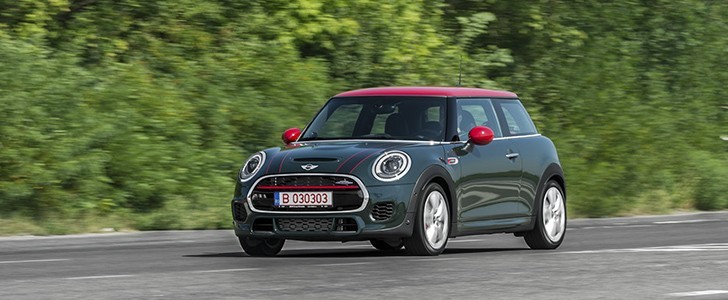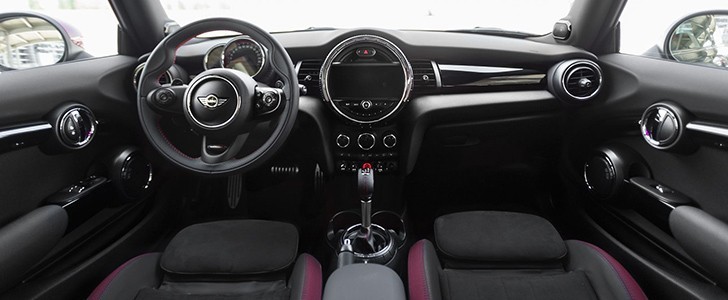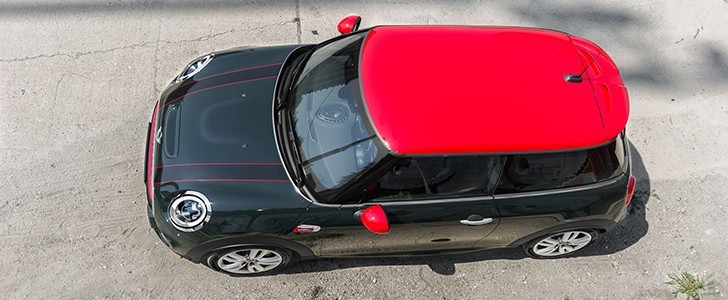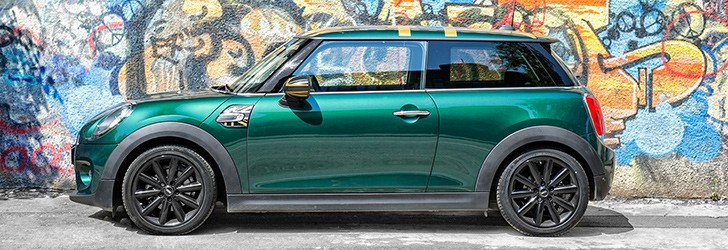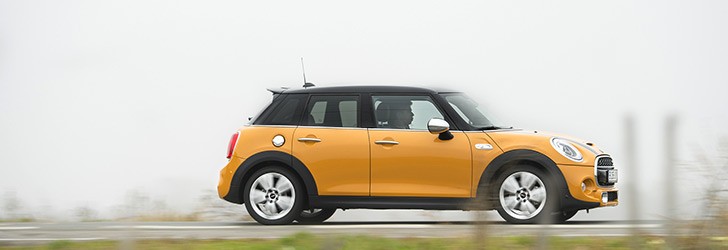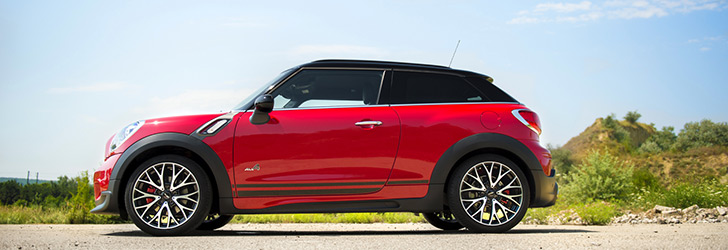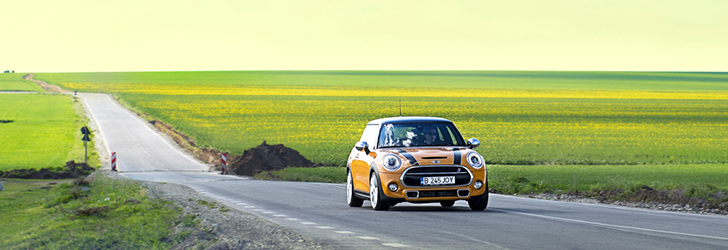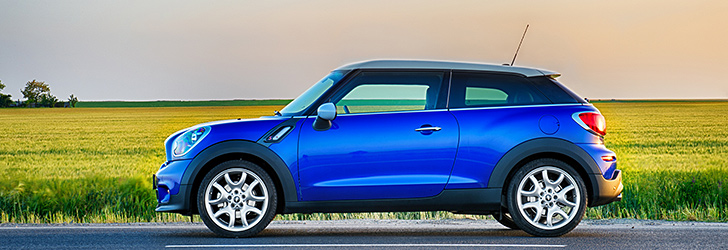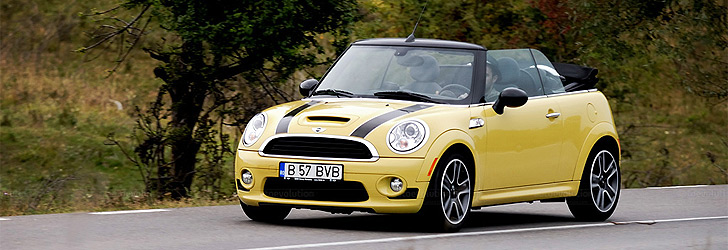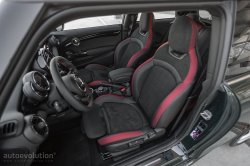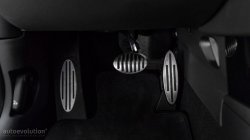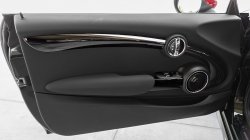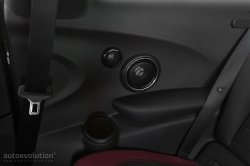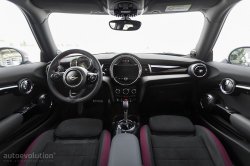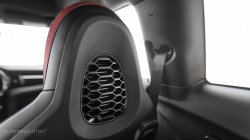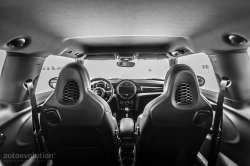2016 MINI John Cooper Works Review
OUR TEST CAR: 2016 MINI John Cooper Works, 2.0T, 6AT, 231 HP
BMW’s product launch strategy has become rather obvious in recent years. After launching the “regular” versions of a model, they tend to wait around at least one full year before revealing the really good stuff, at the other end of the performance stick.
But why are we talking about BMW while reviewing a MINI? Well, in case you haven’t been keeping up with the British brand in the last 15 years, the Germans now own it and they did bring their management philosophy along, including new model launch sequences.
MINI grew a lot under the new management. They posted sales better than ever and, even though last year may have seemed like a downfall, they are now on a record streak, posting the best ever sales figures in the brand’s entire history.
Part of that is played by the new F56 Hardtop, which was criticized at first for being too big or for leaving too much of the MINI legacy behind, but is now starting to prove its worth. The most expensive new model you can get today is the John Cooper Works version of the Hardtop.
Developed by the division that handles only the top end MINIs, the JCW model came out breaking a couple of records in the process. Just like its Cooper S brother, it uses the biggest engine ever fitted to a MINI but in this case, it’s also the most powerful MINI ever built as well as the fastest.
With 231 PS (228 BHP) and 320 Nm (236 lb-ft) of torque, this is not a car for the faint of heart. Acceleration takes just 6.1 or 6.3 seconds depending on the transmission choice and, even though the manual 6-speed is a bit slower, it will be the preferred choice of the buyers.
And understandably so. After all, if you’re willing to pay this much for a MINI, you might as well choose the gearbox that offers the most engaging drive out there. Sure, the automatic does its job well enough but before we get into specifics let’s take a look at what separates the JCW from the Cooper S model at a first glance.
We’re referring to the exterior styling, of course, and the Brits definitely wanted to send a message with this hot hatch. The front end is similar to the one on the Cooper S but now you get extra air intakes everywhere possible.
The front, rectangular ones are sitting lower and have been positioned more towards the front of the car to absorb more air that will, in turn, get fed into the intercoolers hidden behind the bumper. On the sides, the fog lights have vanished and made room for two extra grilles that allow air to flow freely towards the massive brakes that will need additional cooling.
As an interesting detail, a little birdie told us that the brakes were paramount when developing the car and that a lot of alterations were made to it so that 330mm Brembo disks and their adjacent calipers could be used on the JCW.
Looking at the car from the side, you immediately notice just how impressive the stopping power is. As a matter of fact, the rear disks seem like an afterthought compared to the front ones when you stop and pay attention to the difference in size between them.
John Cooper Works badges have been thrown around on the body, from the front grille to the fenders and the boot, being noticeable everywhere you look, both on the outside and the inside, where you'll find some interesting upgrades compared to the Cooper S.
The chronograph-style markings on the large circular center console display represent such a giveaway, just like the checkered flag details on the speedometer. Oh, and did we mention the Alcantara seats? They look absolutely fantastic both up front and in the back.
The rear bumper features bigger exhaust tailpipes right in the middle with more grilles to the sides than on the Cooper S, while the roof gained a spoiler that, according to MINI, actually adds downforce at higher speeds. That should come in handy because, with a top speed of 153 mph (246 km/h), as we told you, this is the fastest car the Brits ever made. Too bad you can’t really feel it.
That’s because the cabin is extremely well insulated and road noise is kept away from your eardrums. The thing is, they just did a too good of a job in this regard and even though the exhaust does make a brilliant sound when going all out, you don’t realize how fast you’re going unless you check the speedometer.
Even the tires are quieter than you’d expect and, considering that the windows are frameless, the wind noise is excellently kept in check. Color us impressed.
However, as I said, that’s not necessarily a good thing all the time as you might be taken by surprise by how fast this car accelerates. This is where the magic done by the JCW package shines. You might think that the engine under the bonnet is the same as the one on the Cooper S just with a different ECU map, but you’d be wrong.
Yes, both units are 2-liter 4-cylinder turbocharged B48 mills but the JCW version has different pistons, a new turbocharged and an upgraded intercooler as well as a modified intake and a new exhaust system that sounds exactly like a popcorn machine when in Sport mode. At least that's what bystanders told us.
It’s the same engine you’ll find on the 225i Active Tourer, the BMW that shares most of its underpinnings with the MINI, both of them being built on the UKL platform. However, unlike on the Bavarian, the Oxford-built car has to get by with less torque, being rated at 320 Nm (236 lb-ft) at most while the German has 350 Nm (258 lb-ft) at its disposal.
Therefore, they fitted a brake-actuated torque vectoring system up front while also working on the suspension setup both up front and in the back. For example, the front gets uprated springs and dampers, strengthened and lighter supports and wishbones while the anti-roll bars are tube-shaped. Support bearings have been lightened as well while strut mounts are now triple-path. Round the back, you’ll find a multi-link suspension that received a similar treatment, being tougher than on the Cooper S.
Even more surprises await right under the engine. The power is sent to the wheels using a system that makes sure driveshafts are equal in size. Basically, there’s an intermediate prop shaft in there that takes the power to two others that then reach each front wheel.
One other essential improvement over the R56 model is the introduction of adaptive dampers, a first for the MINI brand. Using a controller located at the base of the gearshift lever, you can switch between three driving modes: Green, Mid and Sport.
While Green mode turns the car into an unrecognizable snail, it does come with some advantages. Around town it’s a terrible tool to use but if you do your best, you can reach a fuel consumption of 7.8 l/100 km (30 mpg) which is not bad at all if you consider the 2-liter petrol mill used under the bonnet.
Switch to Sport mode though and the whole thing comes alive along with the fuel consumption. That rose to 12 l/100 km (19 mpg) when driving aggressively but then again, that’s how this MINI is meant to be driven and not only you’ll enjoy it, but the car itself will seem to do the same.
The dampers stiffen up and you start feeling every crack in the asphalt while the steering becomes a little heavier but remains balanced and on point. A little more feedback would’ve been welcome, but we’ll take it as it is since hydraulic steering racks have become a thing of the past.
The biggest improvement in Sport mode is related to the throttle response and the way the exhaust sounds. Since the interior is extremely well insulated, you’ll have to accelerate pretty hard to get the car to deliver an excellent aural experience but when it does, the people around you pay attention.
Yes, the JCW MINI sounds great, and that’s one of its most valuable assets as you’d be expecting great sounds to come out of those tailpipes. That’s not all, though. Accelerating will, in turn, spool up the turbocharger and that brings a different tune to your ear, one that may be even more intoxicating than the exhaust pops and cracks altogether.
The 2-liter mill sounds as if a blow-off valve was fitted somewhere inside the engine bay and you hear it every time you press the gas pedal. It’s downright addictive and it makes the Harman / Kardon sound system our tester was fitted with rather useless.
Don’t get us wrong, the HK implementation on the new Hardtop MINI is absolutely brilliant and possibly one of the best on the market, but you’ll rarely use it as you’ll be wanting to hear the engine most of the time. At least that’s what happened to us.
Since the size of the car is identical to every other Hardtop out there, navigating around town in it is as easy to do as in every other new MINI out there. Yes, this is still a city car despite its increase in size and Mid mode will allow you to drive in a considerate fashion.
The one thing you’ll have to be more careful about though is the ground clearance as the square intakes on the front bumper sit lower than on the Cooper S and you might have problems with them when parking.
Other than that, you’ll find that squeezing between cars even on busy days around town is rather easy to do, not only due to the compact size of the JCW but also because you get all the torque the engine can deliver from 1,250 RPM, making it an extremely agile tool. Sure, the whole might of the mill will be felt at between 3,000 and 6,000 RPM but you'll rarely need to go there. You'll do it because you like it, not because you need to.
The tester we had was fitted with the automatic 6-speed gearbox, unfortunately, but we made it work. It's a good slush box, one that will switch gears as fast as you want it to but it's a no cigar moment when compared to the manual in terms of engagement.
In Sport mode you have two choices: keep the gearbox in “D” or tilt the lever to the left. In the first case scenario, the car will shift gears at higher RPM but won't hold the revs up when engine braking. On the other hand it will upshift totally unexpectedly. Tilt the lever to the left and you'll get everything you wanted, including no more pesky upshifts.
With a weight of a little over 1.2 tons and 231 HP at its disposal, you get nearly 200 HP/ton, and that’s a more than decent ratio for any car. To get a better idea of how this thing accelerates, keep in mind that going from 50 mph (80 km/h) to 75 mph (120 km/h) takes just 5.6 seconds. That’s 0.3 seconds faster than a Porsche 911 Carrera S.
And you’ll see that by the plenty outside the city. The John Cooper Works treatment allows you to accelerate to triple digit speeds in no time and even after reaching over 120 km/h (75 mph) you’ll still be finding some get up and go potential whenever you decided to press the gas pedal harder. To be completely frank, the car will accelerate hard to around 100 mph (160 km/h) and start to lose some of its grunt after that but it is a satisfying run nonetheless. And the best bit? We managed to return 5.9 l/100 km (39.8 mpg) outside of town, in Green mode of course.
The front electronic torque-vectoring system does its job well and torque steer is reduced to a minimum. Considering that a mechanical limited-slip differential is missing from the front axle, the understeer is kept under control very well. It’s not on par with the Megane RS 275 Trophy we tested a while back, but it’s pretty close.
Furthermore, due to the short wheelbase of the car, whenever you feel understeer kicking in, you can modulate the way you go around a corner just by lifting off the throttle and you’ll feel the back end sliding in no time, following you in.
All of that does bring some tradeoff too, as the ride isn’t as comfortable as you’d probably prefer and the JCW seats don’t help too much either. Sure, they offer more support than you expect at first but they are not as soft as the ones inside an M car, for example.
Even so, living with a MINI John Cooper Works Hardtop is a lot easier than with some of its rivals. It can be used on a daily basis if you’re willing to live with the limited amount of boot space, the unusable seats in the back and the hard suspension. You’ll be helped a lot by the gadgets the Brits are offering, all at a price, of course.
The Connected system is a revamped version of iDrive, and they are not even trying to hide that. The controls are identical and, as we found on every other new MINI in the range, hard to reach due to the armrest and its position on the center console. Even so, everything is easy to use, and you have support for apps and a cutting edge Navigation system amongst others.
As far as the safety goes, the MINI Cooper received only a four-star rating from the Euro NCAP body, scoring just 56% in safety assist. As standard, you get front airbags, belt pre-tensioners, side airbags, side chest airbags and Isofix in the back. Of course, the seat belt reminder comes as standard too, along with ESC (electronic stability control). At no point during our test did we feel unsafe, despite the NCAP rating.
Therefore, at the end of our time with this car we came to the same conclusion, which is a first for the autoevolution crew. This is the one MINI to get out of the entire line-up. It's raw, it's fun and it's “insane in the membrane” to quote classics. The Cooper S is too tame but this is just right.
The only problem is its pricing and at a starting tag of $30,600 in the US and €29,900 in the EU, you'd have to really love it to spend that much on a hatch, premium or not. Therefore, we'd like to call this the perfect paradox: the one car to get out of the MINI line-up for a price that makes you think twice about it.
MINI grew a lot under the new management. They posted sales better than ever and, even though last year may have seemed like a downfall, they are now on a record streak, posting the best ever sales figures in the brand’s entire history.
Part of that is played by the new F56 Hardtop, which was criticized at first for being too big or for leaving too much of the MINI legacy behind, but is now starting to prove its worth. The most expensive new model you can get today is the John Cooper Works version of the Hardtop.
Developed by the division that handles only the top end MINIs, the JCW model came out breaking a couple of records in the process. Just like its Cooper S brother, it uses the biggest engine ever fitted to a MINI but in this case, it’s also the most powerful MINI ever built as well as the fastest.
With 231 PS (228 BHP) and 320 Nm (236 lb-ft) of torque, this is not a car for the faint of heart. Acceleration takes just 6.1 or 6.3 seconds depending on the transmission choice and, even though the manual 6-speed is a bit slower, it will be the preferred choice of the buyers.
And understandably so. After all, if you’re willing to pay this much for a MINI, you might as well choose the gearbox that offers the most engaging drive out there. Sure, the automatic does its job well enough but before we get into specifics let’s take a look at what separates the JCW from the Cooper S model at a first glance.
We’re referring to the exterior styling, of course, and the Brits definitely wanted to send a message with this hot hatch. The front end is similar to the one on the Cooper S but now you get extra air intakes everywhere possible.
The front, rectangular ones are sitting lower and have been positioned more towards the front of the car to absorb more air that will, in turn, get fed into the intercoolers hidden behind the bumper. On the sides, the fog lights have vanished and made room for two extra grilles that allow air to flow freely towards the massive brakes that will need additional cooling.
As an interesting detail, a little birdie told us that the brakes were paramount when developing the car and that a lot of alterations were made to it so that 330mm Brembo disks and their adjacent calipers could be used on the JCW.
Looking at the car from the side, you immediately notice just how impressive the stopping power is. As a matter of fact, the rear disks seem like an afterthought compared to the front ones when you stop and pay attention to the difference in size between them.
There are plenty of clues thrown around the car that should let you know that this is a special model.
John Cooper Works badges have been thrown around on the body, from the front grille to the fenders and the boot, being noticeable everywhere you look, both on the outside and the inside, where you'll find some interesting upgrades compared to the Cooper S.
The chronograph-style markings on the large circular center console display represent such a giveaway, just like the checkered flag details on the speedometer. Oh, and did we mention the Alcantara seats? They look absolutely fantastic both up front and in the back.
The rear bumper features bigger exhaust tailpipes right in the middle with more grilles to the sides than on the Cooper S, while the roof gained a spoiler that, according to MINI, actually adds downforce at higher speeds. That should come in handy because, with a top speed of 153 mph (246 km/h), as we told you, this is the fastest car the Brits ever made. Too bad you can’t really feel it.
That’s because the cabin is extremely well insulated and road noise is kept away from your eardrums. The thing is, they just did a too good of a job in this regard and even though the exhaust does make a brilliant sound when going all out, you don’t realize how fast you’re going unless you check the speedometer.
Even the tires are quieter than you’d expect and, considering that the windows are frameless, the wind noise is excellently kept in check. Color us impressed.
However, as I said, that’s not necessarily a good thing all the time as you might be taken by surprise by how fast this car accelerates. This is where the magic done by the JCW package shines. You might think that the engine under the bonnet is the same as the one on the Cooper S just with a different ECU map, but you’d be wrong.
Yes, both units are 2-liter 4-cylinder turbocharged B48 mills but the JCW version has different pistons, a new turbocharged and an upgraded intercooler as well as a modified intake and a new exhaust system that sounds exactly like a popcorn machine when in Sport mode. At least that's what bystanders told us.
It’s the same engine you’ll find on the 225i Active Tourer, the BMW that shares most of its underpinnings with the MINI, both of them being built on the UKL platform. However, unlike on the Bavarian, the Oxford-built car has to get by with less torque, being rated at 320 Nm (236 lb-ft) at most while the German has 350 Nm (258 lb-ft) at its disposal.
MINI wanted customers to feel like they are driving something special, and they made sure that the handling is as precise and on point as ever.
Therefore, they fitted a brake-actuated torque vectoring system up front while also working on the suspension setup both up front and in the back. For example, the front gets uprated springs and dampers, strengthened and lighter supports and wishbones while the anti-roll bars are tube-shaped. Support bearings have been lightened as well while strut mounts are now triple-path. Round the back, you’ll find a multi-link suspension that received a similar treatment, being tougher than on the Cooper S.
Even more surprises await right under the engine. The power is sent to the wheels using a system that makes sure driveshafts are equal in size. Basically, there’s an intermediate prop shaft in there that takes the power to two others that then reach each front wheel.
One other essential improvement over the R56 model is the introduction of adaptive dampers, a first for the MINI brand. Using a controller located at the base of the gearshift lever, you can switch between three driving modes: Green, Mid and Sport.
While Green mode turns the car into an unrecognizable snail, it does come with some advantages. Around town it’s a terrible tool to use but if you do your best, you can reach a fuel consumption of 7.8 l/100 km (30 mpg) which is not bad at all if you consider the 2-liter petrol mill used under the bonnet.
Switch to Sport mode though and the whole thing comes alive along with the fuel consumption. That rose to 12 l/100 km (19 mpg) when driving aggressively but then again, that’s how this MINI is meant to be driven and not only you’ll enjoy it, but the car itself will seem to do the same.
The dampers stiffen up and you start feeling every crack in the asphalt while the steering becomes a little heavier but remains balanced and on point. A little more feedback would’ve been welcome, but we’ll take it as it is since hydraulic steering racks have become a thing of the past.
The biggest improvement in Sport mode is related to the throttle response and the way the exhaust sounds. Since the interior is extremely well insulated, you’ll have to accelerate pretty hard to get the car to deliver an excellent aural experience but when it does, the people around you pay attention.
Yes, the JCW MINI sounds great, and that’s one of its most valuable assets as you’d be expecting great sounds to come out of those tailpipes. That’s not all, though. Accelerating will, in turn, spool up the turbocharger and that brings a different tune to your ear, one that may be even more intoxicating than the exhaust pops and cracks altogether.
The 2-liter mill sounds as if a blow-off valve was fitted somewhere inside the engine bay and you hear it every time you press the gas pedal. It’s downright addictive and it makes the Harman / Kardon sound system our tester was fitted with rather useless.
Don’t get us wrong, the HK implementation on the new Hardtop MINI is absolutely brilliant and possibly one of the best on the market, but you’ll rarely use it as you’ll be wanting to hear the engine most of the time. At least that’s what happened to us.
Since the size of the car is identical to every other Hardtop out there, navigating around town in it is as easy to do as in every other new MINI out there. Yes, this is still a city car despite its increase in size and Mid mode will allow you to drive in a considerate fashion.
The one thing you’ll have to be more careful about though is the ground clearance as the square intakes on the front bumper sit lower than on the Cooper S and you might have problems with them when parking.
Other than that, you’ll find that squeezing between cars even on busy days around town is rather easy to do, not only due to the compact size of the JCW but also because you get all the torque the engine can deliver from 1,250 RPM, making it an extremely agile tool. Sure, the whole might of the mill will be felt at between 3,000 and 6,000 RPM but you'll rarely need to go there. You'll do it because you like it, not because you need to.
The tester we had was fitted with the automatic 6-speed gearbox, unfortunately, but we made it work. It's a good slush box, one that will switch gears as fast as you want it to but it's a no cigar moment when compared to the manual in terms of engagement.
In Sport mode you have two choices: keep the gearbox in “D” or tilt the lever to the left. In the first case scenario, the car will shift gears at higher RPM but won't hold the revs up when engine braking. On the other hand it will upshift totally unexpectedly. Tilt the lever to the left and you'll get everything you wanted, including no more pesky upshifts.
With a weight of a little over 1.2 tons and 231 HP at its disposal, you get nearly 200 HP/ton, and that’s a more than decent ratio for any car. To get a better idea of how this thing accelerates, keep in mind that going from 50 mph (80 km/h) to 75 mph (120 km/h) takes just 5.6 seconds. That’s 0.3 seconds faster than a Porsche 911 Carrera S.
And you’ll see that by the plenty outside the city. The John Cooper Works treatment allows you to accelerate to triple digit speeds in no time and even after reaching over 120 km/h (75 mph) you’ll still be finding some get up and go potential whenever you decided to press the gas pedal harder. To be completely frank, the car will accelerate hard to around 100 mph (160 km/h) and start to lose some of its grunt after that but it is a satisfying run nonetheless. And the best bit? We managed to return 5.9 l/100 km (39.8 mpg) outside of town, in Green mode of course.
The front electronic torque-vectoring system does its job well and torque steer is reduced to a minimum. Considering that a mechanical limited-slip differential is missing from the front axle, the understeer is kept under control very well. It’s not on par with the Megane RS 275 Trophy we tested a while back, but it’s pretty close.
Furthermore, due to the short wheelbase of the car, whenever you feel understeer kicking in, you can modulate the way you go around a corner just by lifting off the throttle and you’ll feel the back end sliding in no time, following you in.
All of that does bring some tradeoff too, as the ride isn’t as comfortable as you’d probably prefer and the JCW seats don’t help too much either. Sure, they offer more support than you expect at first but they are not as soft as the ones inside an M car, for example.
Even so, living with a MINI John Cooper Works Hardtop is a lot easier than with some of its rivals. It can be used on a daily basis if you’re willing to live with the limited amount of boot space, the unusable seats in the back and the hard suspension. You’ll be helped a lot by the gadgets the Brits are offering, all at a price, of course.
The Connected system is a revamped version of iDrive, and they are not even trying to hide that. The controls are identical and, as we found on every other new MINI in the range, hard to reach due to the armrest and its position on the center console. Even so, everything is easy to use, and you have support for apps and a cutting edge Navigation system amongst others.
As far as the safety goes, the MINI Cooper received only a four-star rating from the Euro NCAP body, scoring just 56% in safety assist. As standard, you get front airbags, belt pre-tensioners, side airbags, side chest airbags and Isofix in the back. Of course, the seat belt reminder comes as standard too, along with ESC (electronic stability control). At no point during our test did we feel unsafe, despite the NCAP rating.
If you’re looking for a purist’s wet dream on a track, you’d better wait for the MINI John Cooper Works GP version.
Therefore, at the end of our time with this car we came to the same conclusion, which is a first for the autoevolution crew. This is the one MINI to get out of the entire line-up. It's raw, it's fun and it's “insane in the membrane” to quote classics. The Cooper S is too tame but this is just right.
The only problem is its pricing and at a starting tag of $30,600 in the US and €29,900 in the EU, you'd have to really love it to spend that much on a hatch, premium or not. Therefore, we'd like to call this the perfect paradox: the one car to get out of the MINI line-up for a price that makes you think twice about it.
Our MINI Testdrives:
Photo gallery (66)
